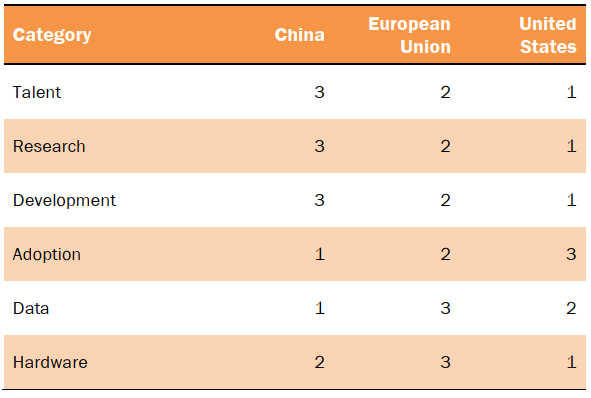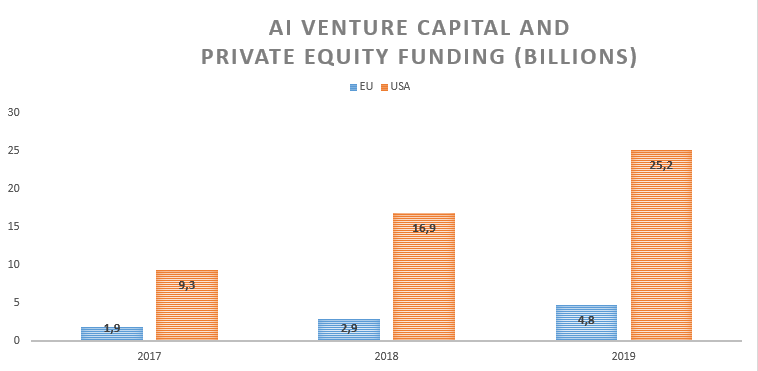Who can break away in the AI race
Artificial Intelligence is the trending topic today and it will remain for the next years. So it might be reasonable to take a closed look at the environment and international players, who are participaiting the current area of AI.
A case study of Center for Data Innovation compares the strenghts and weaknesses of leading nations. Competitiveness of China, EU and USA is explored in the areas of the development and research of AI. The report investigates the current state based on the six metrics: talent, research, development, adoption, data, and hardware. Those economies have been chosen, because they are the largest and consistently outperform their peers in the six categories.
Methodology
Before to take a closer look at the results, conclussion and the recommendations of the case study, the methodology and the reasons of picking those metrics are to be explained.
Talent
First, nations with the requisite AI talent will be able to better develop and implement AI systems. In addition the business attraction is higher in case of talented ressources. The availability of talented professors for Artificial Intelliegnce at universities ensures that a knwoledge transfer to the next generation of AI researchers.
Research
Second, research will help nations expand AI innovation and solve problems related to domestic priorities and industries.
Development & Start-up
Third, the number of AI companies and start-ups, combined with related investment capital, lays the groundwork for a strong AI industry that will continue to innovate.
Adoption of AI
Fourth, adoption of AI systems will not only allow organizations to learn how to solve problems related to implementation, but generate demand for AI services, thereby likely helping domestic AI developers.
Data
Fifth, more and higher-quality data will create new opportunities to use machine learning in AI applications.
Infrastructure
Finally, leading in hardware will reduce nations’dependency on other nations—something that, given the current trade dispute between China and the United States, may play an important role going forward.
Results
Overall, the United States currently leads in AI, with China rapidly catching up, and the European Union behind both.

The United States leads in four of the six categories of metrics this report examines (talent, research, development and hardware), China leads in two (adoption and data), and the European Union leads in none—although it is closely behind the United States in talent.
Substantiation
Results seem not to be really suprising.
USA is currently leading the AI race
The United States leads for several reasons. First, it has the most AI startups. Having the most Artificial Intelligence start-ups and providing the start-up friendly eco-system US is offering enough nutritious soil for a new disruptive technology to grow. Last but not least, the financial component also plays an important role here. US start-up ecosystem received the most private equity and venture capital funding. Second, it leads in the development of both traditional semiconductors and the computer chips that power AI systems.
Next point is related to the talents,which are working in the sphere of Artificial Intelligence. USA has less overall talent than EU and China, but it is more elite. With regard to the lack of talent, the USA is proceeding in such a way that the gap is closed through acquisition. The top-class talents are obtained through insourcing in the EU and other countries.
And finally… of course the press.
While US produces fewer technical scholarly papers than the EU or China, it produces the highest-quality papers on average. USA leads the race and continuously secures the position through the elite research organizations and considerable expenses. Another reason for US leading position is the number of start-up established and backed by a venture capital. Also patent and acquisition data reveals that the United States already has a significant lead in developing worldclass AI firms.
China is catching up in areas of AI
China seems to reduce the gap between itself and USA very quickly. The reason for the rapid catch-up speed is the growing the venture capital as well as private equity inflow, but of course also the immense volume of availabe data and an easier access to it. Data availability is very important, because many of today’s AI systems use large datasets to train their models accurately. In venture capital and private equity funding, Chinese start-ups received more funding than U.S. start-ups in 2017, but not in 2016 or 2018. Another important factor of the growth is the fast adaption of artificial intellienge within the chinese economy. Due to the research 53% of chinese firms piloted AI by 2018. China, however, is clearly behind both the United States and the European Union in high-quality talent. But China is decreasing the lack of talents by financing the education.
Why european AI is falling behind
The European Union has the talent to compete with the United States and China. Indeed, it has more AI researchers than its peers, and typically produces the most research as well. Probably the biggest problem is the lack of or insufficient support for the start-up sector in the EU and especially in Germany. Given that the European Union’s laggard position reduces its ability to not only enjoy the economic and social benefits of AI, but also influence global AI governance, which is a goal of the European Commission. The inadequate capital inflow makes it very difficult for the european start-up eco-system to grow, thus it influences the lagging development of the AI sector.

Conclussion
Many believe countries do not compete when it comes to innovation. Nowadays this approach is really applicable to the areas of innovations such as AI. Technological innovation is key to raising standards of living, and AI is likely to be a primary driver of technological innovation in the emerging innovation wave.140 Indeed, technology adoption is estimated to create $13 trillion of gross domestic product (GDP) growth by 2030. Firms increasingly need to adopt AI in order to remain competitive in the global economy because it allows them to automate and optimize many facets of their business, derive faster and more accurate insights from data, and develop new products and services.
Nations wherein firms fail to develop successful products or services are at risk of losing global market share. That is why Trump signs order on principles for U.S. government AI use. The adoption of such principles will determine, who will be Google, Amazon or Apple in the coming years. Nations that lag in AI adoption will see diminished global market share in a host of industries, from finance to manufacturing to mining. And nations that underinvest in R&D, particularly for military applications, will put their national security at risk. Consequently, nations that fall behind in the AI race can suffer economic harm and weakened national security, thereby diminishing their geopolitical influence.
Recommendation
Based on the results of the case study and AI being the top priority of the coming years there must be an adjustment of the European Union strategy regarding R&D of artificial intelligence.
The support for AI startup’s in regards of venture capital as well as respective startup eco-system need to be improved. There are several reasons for that. First, number of companies and start-ups, combined with related investment capital, lays the groundwork for a strong AI industry that will continue to innovate. Second, similar to other technology-based start-ups, AI start-ups can be an important driver of a nation’s economic growth and competitiveness.
Given the fact that only 26% of firms are adopting the artificial intelligence within its own businesses, way of conveying the importance of AI is vital and needs to be established by the private economic sector as well as goverment. Adoption of AI systems will not only allow organizations to learn how to solve problems related to implementation, but generate demand for AI services, thereby likely helping domestic developers.
As already mentioned EU has to take the advantage of the existing AI talents. Since a lot of ressources are leaving the european firms and getting hired in USA, EU has should support policies that encourage researchers and entrepreneurs to stay or even to move to the EU.
Since data is used as an ultimateive source for artificial intelliegnce (fixed broadband subscriptions, mobile payments, productivity data, high-resolution mapping data), data protection regulations may affect the amount of data available. EUs regulatory environment creates the most restrictions on the collection and use of data. It is crucial to make more data available and accessable. Given that regulatory environment needs to be adjusted in a way that organizations are able use and the data in a proper way for training and improvement of the respective algorithms.


